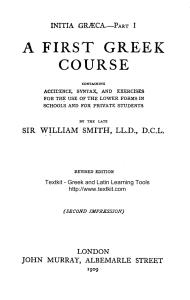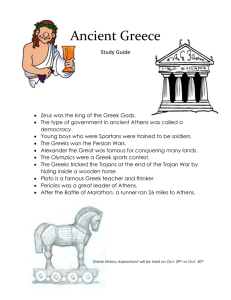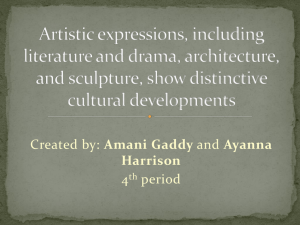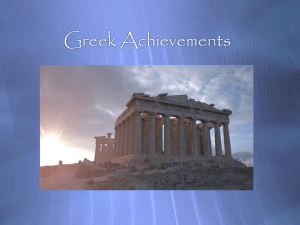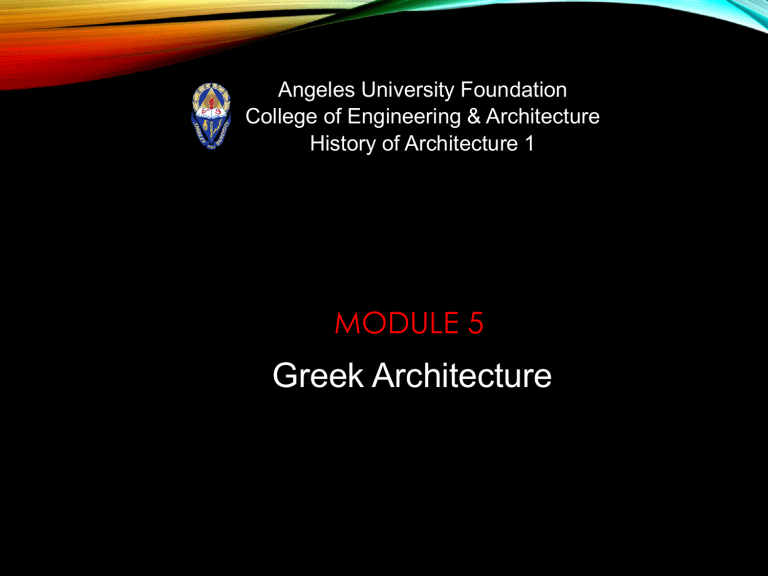
Angeles University Foundation College of Engineering & Architecture History of Architecture 1 MODULE 5 Greek Architecture GREEK ARCHITECTURE Topics •Social Characteristics •Architecture - Classical Orders •Temple Architecture – Partheneon ,Hera Argiva , Erechtheion ,Temple of Nike , Corinthian Temples •Civic Buildings •Material – Construction Technology SOCIAL CHARACTERISTICS SOCIAL CHARACTERISTICS Greek civilization is the first major civilization in Europe The ancient Greeks lived in self governing city-states called “Polis." – The ancient Greek world was made up of hundreds of these independent city states – They were all bounded by common language and religious beliefs. – They all made efforts to preserve their own unique identity, and each city state believed that their state was better than all the other states. – The city states often fought with one another. – The scale of the polis was small. – The city state of Athens on the Greek mainland was among the most famous and powerful of the city states . – It was a major center for learning and the arts. – When city-states were first formed, they were ruled by a few wealthy men. However, they gradually moved towards democracy. – Athens developed an early form of democracy How did they make laws? Only men who were born in Athens were allowed to vote. They did this at public assemblies where upper class citizens discussed and adopted laws that might benefit Athens. ARCHITECTURE ARCHITECTURE The Greeks convinced themselves that the secrets of beauty lie in proportions. – Man was viewed by the Greeks as having the most ideal proportions and is the measure of all things – With time, they refined their system of building proportion, and developed the classical Greek orders. – Greek construction was of a simple post and lintel or trabeated construction – Their ground plans were always very simple, usually rectangular THE CLASSICAL ORDERS DORIC, IONIC AND CORINTHIAN Each order consist of: Upright column Entablature Upright column consist of: Base Shaft Capital Entablature consists of: Architrave (lower part) Frieze (middle part) Cornice (upper Part ) THE CLASSICAL ORDERS DORIC, IONIC AND CORINTHIAN Consists of Upright column ( base , shaft and capital ) and the horizontal entablature. Entablature consists of architrave ( lower part ) , frieze ( middle part ) , and cornice ( Upper Part ) Doric Masculine, Serious, And Dignified Ionic Feminine, Light, Delicate And Elegant. Corinthian Grandiose DORIC ORDER • The Doric order was the earliest to be developed. Used in temple Parthenon at Athens. • The Doric order is made up of three elements: Stylobate (crepidoma) Column Entablature • The stylobate( Crepidoma )is a podium raised three steps on which the temple stands. • The Doric column is further divided into the shaft and a square capital . • It had a height of 7 times its diameter. DORIC ORDER • The shaft is tapered and made to bulge slightly to provide correction for optical illusion. • Entasis refers to the practice of optical correction in Greek Doric temples • The shaft is usually divided into 20 shallow flutes. • The entablature is divided into an architrave, a frieze and the cornice. • The Doric column represents the proportions of a man’s body, its strength and beauty. ORDERS OF GREEK ARCHITECTURE Doric Order Ionic Order Corinthian Order • The ionic column including the capital and base had a height of 9 times its diameter • It had 24 flutes, which is more than that of the Doric column, even though it is smaller in diameter. • The Ionic order had a capital developed from a pair of volute about two-thirds the diameter of the column in height • Ornaments are used to decorate the capital and the volute. • Entasis was not applied to the ionic column IONIC ORDER CORINTHIAN ORDER • The Corinthian order takes its name from the city of Corinth in Greece • This order is similar in its proportions to the Ionic order but has a different capital • The core of the capital is shaped like an inverted bel. • The bell-like capital is decorated with rows of carved acanthus leaves. • Because of its symmetry, the Corinthian capital unlike the ionic capital is designed to be seen from all directions. COLUMN CONSTRUCTION • Each column was made up of several drums of marble • They were held together by a stone peg in the center • The stones were assembled and put together in their rough form. • the grooves called flutes were cut up and down the shaft of the column and all around it TEMPLE ARCHITECTURE • Hellenistic Period The temple is usually rectangular in plan • The temple always faced east so that the rising sun would light the statues inside • It is stood on crepidoma of 3 or more steps. • Colonnades define a portico around the temple and support the triangular shaped Pediment • Naos - It contains the statue of God with treasury chambers in front and rear known as Pronaos and Epinaos . It is is made up of four walls enclosing a rectangular space . • Internal space ofNaos is framed by a pair of colonnades on the long side creating a central processional space • Statue of God was centrally located within a naos, or chapel. DORIC TEMPLES Temple of Parthenon at Athens ( 447-432 B.C.) •Octa -style in Plan (17 columns on sides) •Crepidoma measures 101’4”x 228’ • Naos - 19mx30m •West of Naos was Parthenon accessed by opisthodomos •Ambulatory 7’-0 wide on sides and 11’ wide at front and rear , Wall 4’ thick •All columns are 10.4m high and about 1.88m in diameter and of Doric order . • Dedicated to Athena, goddess of wisdom • Built after the Persian Wars • Commissioned by Pericles • Architects: Ictinus and Callicrates • Sculptor: Phidias • Sculpture both inside and outside temple East pediment: Birth of Athena • • West pediment: Contest between Athena and Poseidon for Athens Temple of Parthenon at Athens TEMPLE OF HERA ARGIVA AT PAESTUM • The temple is hexastyle but with 24 columns on its flank • It also has a double row of columns in the interior, and divided into two separated by a stone architrave • The most perfect of the Doric temples is the Parthenon IONIC TEMPLES THE ERECTHEION • The Erechtheion or erechtheum is an ancient greek temple on north side of the Acropolis of Athens . • Built between 421 and 406 B.C. Sculpture and mason – Phidias . • The shape of the erechtheum is not a perfect rectangular and it does not have a colonnade surrounding it . • Two porches spring out from the core rectangle of the temple at different levels • A small porch faces the Parthenon THE ERECTHEION • This has columns in the shape of a woman called caryatid . • Greeks copied the Caryatid slave women in stone and forced them to carry the roof . • The weight of the roof is carried from the top of the head of the caryatid through their leg • A larger porch on the northern side has ionic columns • The ionic columns have all the characteristics of the Ionic order THE ERECHTHEION TEMPLE AT ATHENS • Distance of column to column is 4D c to c. Temple of Nike • Just beside the propylae is the Temple of Athena Nike, meaning victorious Athena • It was built around 420 BC and was designed by Callicrates. • The Athenians worshipped Athena Nike in the hope of victory CORINTHIAN TEMPLES • The Corinthian order was not widely used during the Greek period. • The temple of Olympian Zeus in Athens was in the Corinthian order • The Corinthian order became very popular during the Roman period. THEATERS L - 24,ARCHITECTURAL FEATURES OF THEATERS OF DIONYSOS OF ATHENS ANDEPIDAUROS • The Greeks invented the theater design that is still used in movies and auditoriums today. • Every important Greek city had a theater • Their theater was built into a hilly landscape. • The theater had a bank of seats steps created from the landscape. THEATER OF DIONYSOS (500 BC-ATHENS) • Major open-air theatre . • It was used for festivals in honor of the god Dionysus. •Situated on towards the South slope of the Acropolis •It contains – Orchestra, Auditorium and Skene of building . •It had a capacity of 18,000 spectators. •67 marble thrones for kings , priests and noble people. •2 horizontal path ways “Diazoma ” were provided THEATER OF EPIDAUROS (500 BC-ATHENS) •Epidauros theatre is the most beautiful and best preserved . •Their theater was built into a hilly landscape •The theater had a bank of seats steps created from the landscape. •It had a capacity of 13,000 spectators THEATER OF EPIDAUROS (500 BC-ATHENS) •It was divided into two parts: seats aimed for the citizens and aimed for the priests and rulers. •Have good acoustics •This was the largest theater in ancient Greece. •It is still in use today STADIUMS THE STADIUM OF OLYMPIA, GREECE (LOCATED TO THE EAST OF THE SANCTUARY OF ZEUS.) •Stadium was a holy place for the ancient Greeks. •The stadium could hold 50,000 spectators. •The track were of 3 types . •All the seats were made of mud and on the southern slope there was a stone platform . •Stadiums were mainly used to hold games. •Games further expanded in different events like horse race , jumping , wrestling and many other excluding swimming . •Conduits ran around the track to drain off excess rainfall OTHER GREEK BUILDING TYPES PROPYLAE • The propylae is the imposing entrance gates to the Acropolis or upper city • It was built around 437 B.C by Architect Mnesicles • To reach the acropolis, people had to enter through the center section of the propylae • The columns on the outside of the propylae were Doric • The columns in the interior were however Ionic. • Designed to view of buildings as a 3 dimensional object . COUNCIL CHAMBER BOULETERION, MILETUS • This was a council hall . • Used as a meeting place by the elected councillors • It was a covered chamber fitted with banks of seats like a theater • The example shown is from the city of Miletus • Similar buildings were found in every Greek or Hellenistic City Greek City Planning and Design Planning and Design Principles • The ancient Greek civilization had established principles for planning and designing cities • City form were of 2 types • Old cities such as Athens had irregular street plans reflecting gradual organic development • New cities, especially colonial cities established during the Hellenistic period, had a grid-iron street plan . • Principle of Straight and Wide streets . The Greek City was usually divided into three parts; the Acropolis, the Agora and the Town. The location of buildings was therefore such that it could command a good view to it. The Acropolis was the city of temples . It is the location where all the major temples of a city are located. The Acropolis were usually located on the highest ground. The Acropolis and Agora in Athens also have some of the best examples of ancient Greek architecture. THE ACROPOLIS IN ATHENS, GREECE •Towns - developed a standard plan of the city. •Town was made up of only residential houses. •Houses were usually constructed of mud bricks. •Houses were of the courtyard type, with rooms arranged around a courtyard. •The walls were coated with stucco outside. Athenian Agora It has an organic plan. THE AGORA • The Agora in Athens was a space used for social, commercial and political activities • It was a city square or an open air market place. • Located at the base of the hill of the Acropolis • Civic and religious buildings were progressively erected around the perimeter of the Agora space THE AGORA • Agora was in the center and includes : • Assembly hall • Council hall • Chamber hall • Of all the buildings, the stoa was the most important • Stoa were useful buildings in the context of the Agora. Approx. of size of 100m long and 10m wide • They provided shelter and served for many other purposes . • They also served to embellish the boundary of the Agora Materials, Construction & Technology Materials • Three common materials of construction are: - Stone - Timber - Clay • Stone was the most common construction material for buildings. • Greece had an abundant supply of stone, particularly marble Stone was used for all types of temple and civic construction • The characteristic grey color of the stone of the area gives most ancient Greek buildings their characteristics color. • Timber was used mostly for roofing . • Clay was made into sun dried blocks for use in construction Construction and Technology • Stone blocks were large and retained in position by their own weight; it was not necessary to fix them together in any way. • Then the rough stones were finished to achieve the final form and treatment of the building. • It is in finishing that the Greeks showed their mastery of construction. • Finishing work involved creating the fluting, base and capital decoration on columns. • The Frieze and cornices of buildings were also decorated with appropriate relief carving.
